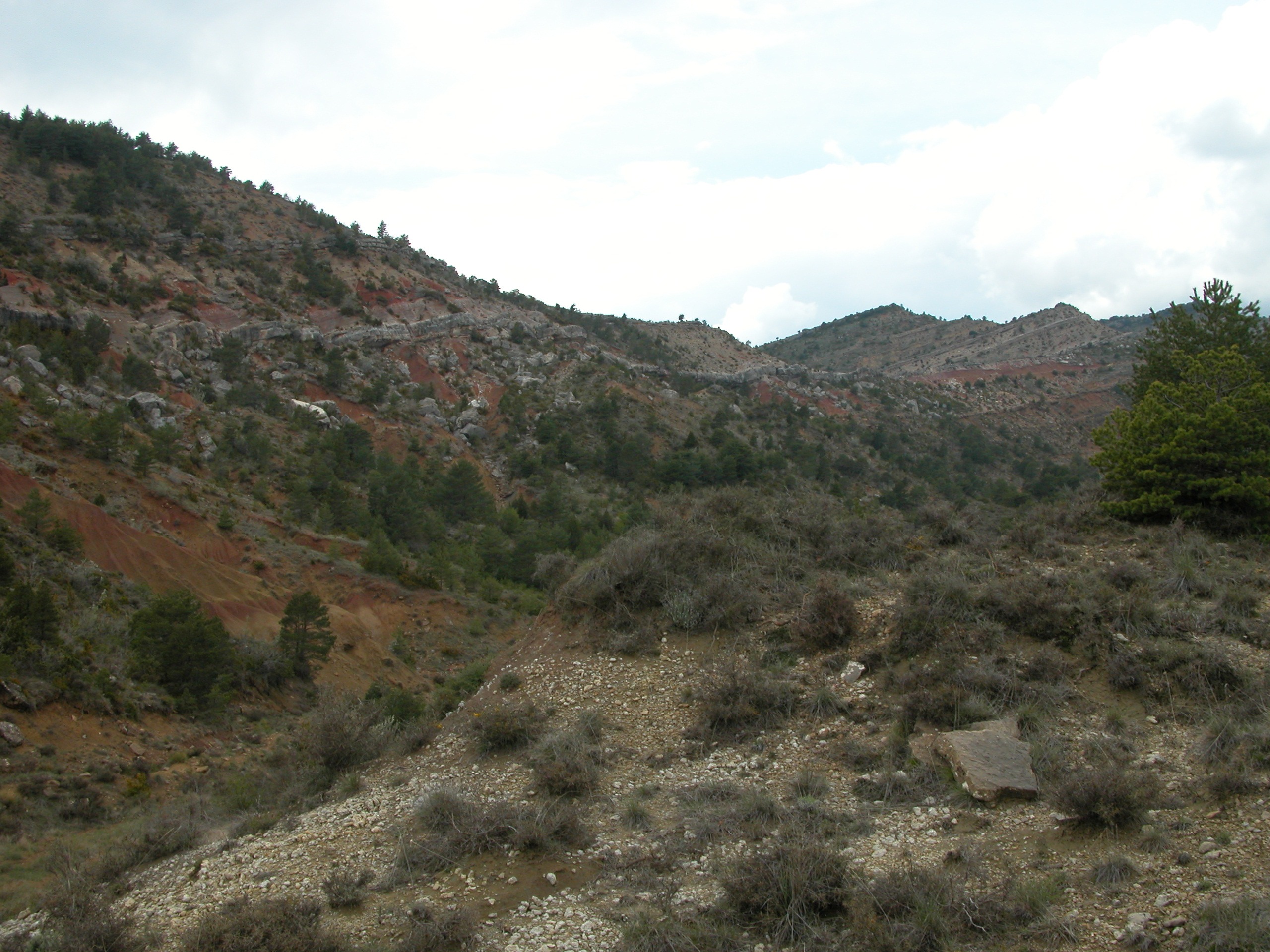LOCALIZACIÓN:
TIPO YACIMIENTO: Dinosaurios
EDAD: Cretácico superior (Maastrichtiense)
TIPO DE HALLAZGOS: Huesos fósiles
ORGANISMOS: Sauropoda, Titanosauria, Quelonia
ROCA QUE LOS CONTIENE: Margas grises de la Formación Tremp
Descripción:
El saurópodo titanosaurio de Serraduy
Junto a Arén, Serraduy tiene el privilegio de ser las dos localidades donde se han encontrado restos de dinosaurios en Huesca. Hasta el momento solo es un fragmento proximal de un fémur de un saurópodo titanosaurio, pero hay buenas expectativas que se puedan encontrar más restos. El fragmento de fémur se encontró en unas rocas de aproximadamente 65 millones de años (Maastrichtiense superior), lo que hace el fósil de saurópodo más moderno de Europa. Lo más sorprendente de este fósil es su gran tamaño. Si estuviese entero, podría llegar a tener 1,30 de longitud, lo que implica un dinosaurio de más de 15 metros. Este tamaño es inexperado, ya que al final de la época de los dinosaurios (límite K/T), el resto de saurópodos que se conocen suelen ser de pequeño tamaño.
Este fósil fue encontrado por el geólogo Lluis Ardévol en el transcurso de la realización de un mapa geológico, al comienzo de la década de los 1990. Dado lo inaccesible del yacimiento fue necesario el traslado de manera manual, en el que participaron el descubridor, José Ignacio Canudo y José Antonio Andrés, técnico en paleontología del Gobierno de Aragón. Una vez preparado, fue objeto de un par de publicaciones científicas (Canudo et al., 1999; Canudo, 2001). Desgraciadamente no se han vuelto a encontrar nuevos restos de este titán. El fémur se encuentra depositado actualmente en el Museo Paleontológico de la Universidad de Zaragoza.
Junto al fémur se han encontrado varias placas de Bothremydidae indet. una grupo de tortugas muy comunes al final del Cretácico en el Pirineo español.
Publicaciones significativas:
Canudo, J. I., Cuenca Bescos, G, Ardévol, Ll. y Lopez Martínez, N. 1999. The youngest sauropod of western Europe. En: IV European workshop on Vertebrate Paleontology, Albarracín Junio 1999, 30.
Canudo, J. I. 2001. Descripcion de un fragmento proximal de fémur de Titanosauridae (Dinosauria, Sauropoda) del Maastrichtiense superior de Serraduy (Huesca). En: XVII Jornadas de la Sociedad Española de Paleontología. Los fósiles y la Paleogeografía. Albarracín. 1, 255-262. [Ver artículo]
 Description:
Description:
The titanosaur sauropod of Serraduy Together with Arén, Serraduy is one of the two localities in Huesca where dinosaur remains have been found. The only fossil discovered so far is a proximal fragment of a femur from a titanosaur sauropod, but hopes are high that more remains may yet be found. The femur fragment was found in rocks dating from approximately 65 million years ago (Upper Maastrichtian), making it the most modern sauropod fossil in Europe. The most surprising thing about this fossil is how big it is. If it were complete, it could be as much as 1.30 metres in length, suggesting that the dinosaur was more than 15 metres long. Such a size is unexpected, since at the end of the dinosaur era (around the K-T boundary), all the other known sauropods tend to be smaller. The fossil was found by the geologist Lluis Ardévol in the course of his work on the preparation of a geological map of the area in the early 1990s. Given the inaccessibility of the site, it was necessary to move it by hand. This task was carried out by the discoverer of the fossil, José Ignacio Canudo and José Antonio Andrés, a palaeontological technician from the Government of Aragon. Once preparations were complete, it was the subject of two scientific papers (Canudo et al., 1999; Canudo, 2001). Unfortunately, no further remains of the titan have so far been found. The femur is currently being kept in the Palaeontological Museum of the University of Zaragoza. As well as the femur, various plates from Bothremydidae indet. have been found. This is a group of turtles that were very common at the end of the Cretaceous in the Spanish Pyrenees. Important publications: Canudo, J. I., Cuenca Bescos, G, Ardévol, Ll. y Lopez Martínez, N. 1999. The youngest sauropod of western Europe. En: IV European workshop on Vertebrate Paleontology, Albarracín Junio 1999, 30. Canudo, J. I. 2001. Descripcion de un fragmento proximal de fémur de Titanosauridae (Dinosauria, Sauropoda) del Maastrichtiense superior de Serraduy (Huesca). En: XVII Jornadas de la Sociedad Española de Paleontología. Los fósiles y la Paleogeografía. Albarracín. 1, 255-262







 Description:
Description:














